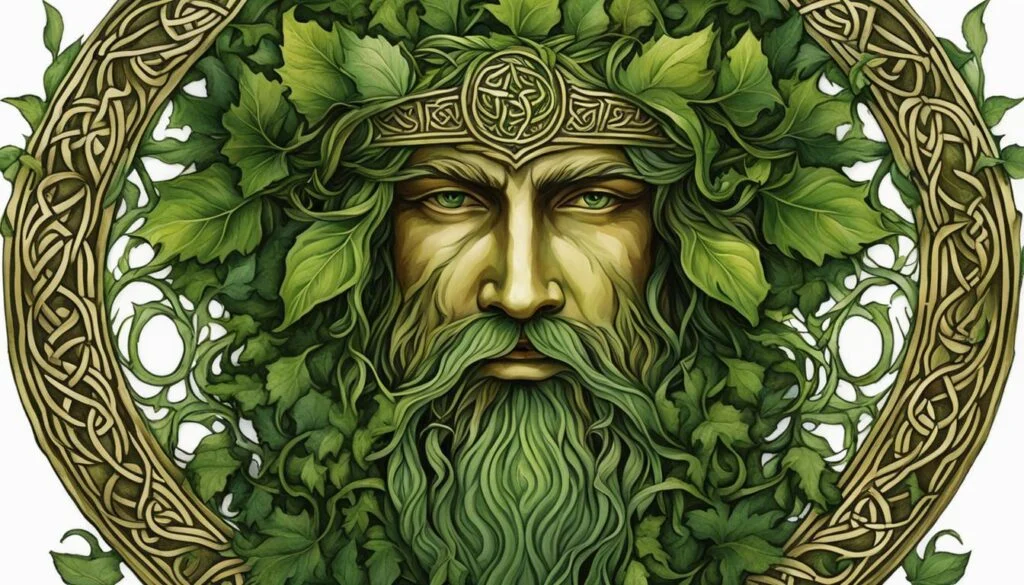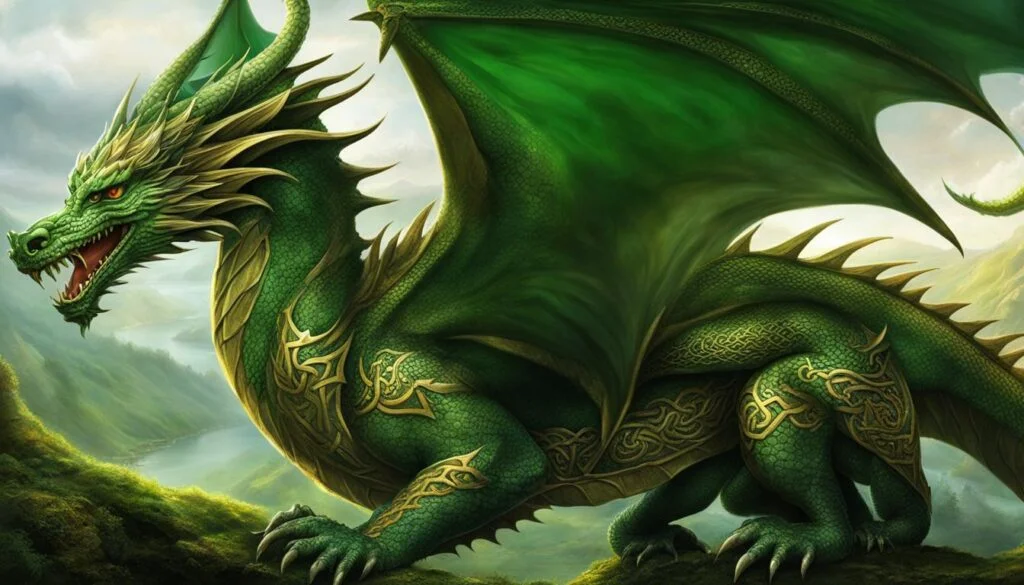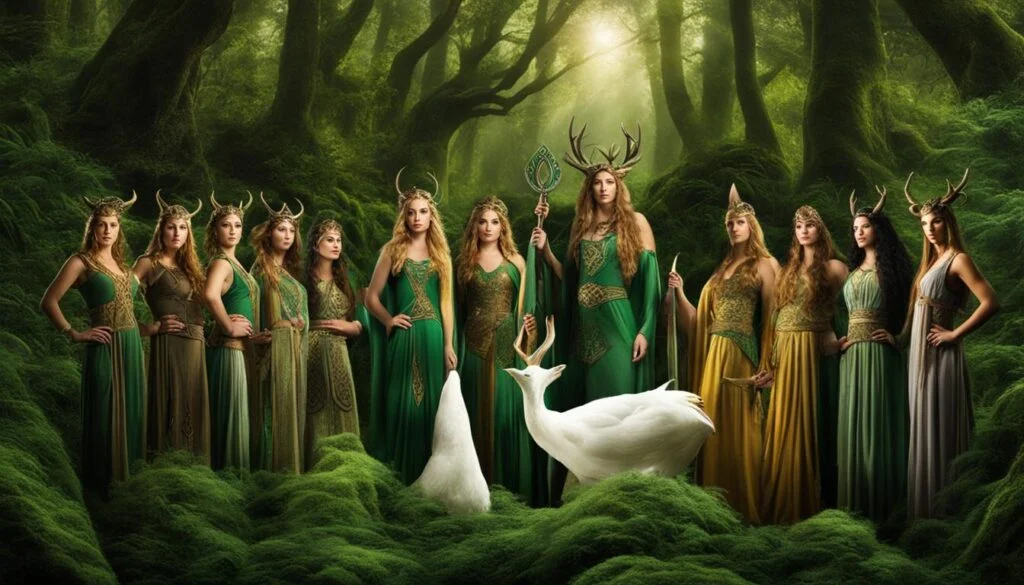Welcome to a mystical journey into the world of the Green Man, a captivating figure deeply ingrained in Celtic lore and symbolism.
The Green Man is a nature deity who symbolizes the cyclical nature of life and the profound connection between humans and the natural world. Through mythology, folklore, and Pagan beliefs, the Green Man embodies the spiritual significance of nature and serves as a divine symbol of rebirth and renewal.
The Green Man’s enduring presence throughout history reminds us of our interconnectedness with the environment and the eternal cycle of birth, growth, decay, and transformation.
This ancient symbol continues to captivate and inspire individuals seeking a deeper connection to the natural world and a profound sense of spirituality.
Key Takeaways:
- The Green Man is a symbol deeply rooted in Celtic lore and is associated with the cyclical nature of life and nature deity.
- Through mythology, folklore, and Pagan beliefs, the Green Man represents the spiritual significance of nature and the divine symbol of rebirth and renewal.
- The Green Man serves as a reminder of our interconnectedness with the environment and the eternal cycle of birth, growth, decay, and transformation.
- His enduring presence continues to captivate and inspire individuals seeking a deeper connection to the natural world and a profound sense of spirituality.
- Exploring the Green Man’s symbolism invites us to embrace the cycles of life and find renewal and transformation through our connection to nature.
The Presence of the Green Man in Medieval Churches
The presence of the Green Man can be found in medieval churches throughout Great Britain.
Carvings and images of Green Men can be found both inside and outside these churches, showcasing their widespread and significant presence.
The Green Men in these churches are often depicted as whimsical and enigmatic faces, adorned with foliage and vines.
They serve as a visual representation of the Green Man’s connection to nature and his role as a symbol of life and rebirth.
These striking and intricate carvings can be found in the intricate stonework of the churches, on corbels, capitals, misericords, and other architectural elements.
The Green Man’s presence in these sacred spaces reflects the deep connection between spirituality and nature, as well as the reverence for the cycles of life.
Fascinating Examples of Green Men in Medieval Churches
- At St. Mary’s Church in Arundel, West Sussex, England, visitors can marvel at a stone Green Man who is said to be weeping leaves.
. - In the Rosslyn Chapel in Scotland, a Green Man can be found among the intricate carvings on one of the chapel’s pillars.
. - The Carlisle Cathedral in Cumbria, England, is adorned with numerous Green Men carvings, including one on a misericord showing a man’s head sprouting foliage.
These are just a few examples of the Green Man’s presence in medieval churches, serving as a testament to the enduring fascination and symbolism that surrounds this mythical figure.
The Revival of the Green Man
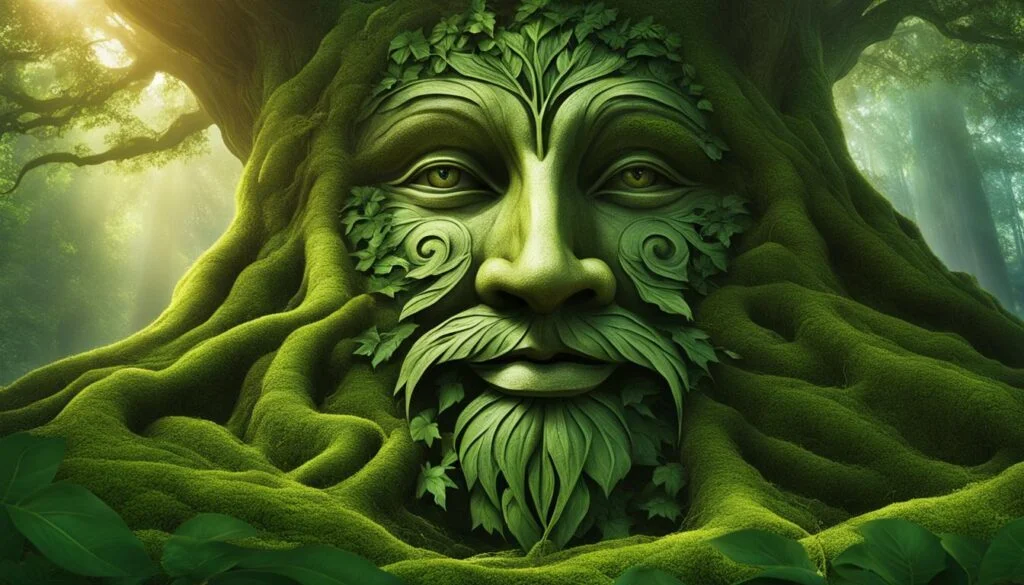
In recent years, the Green Man has experienced a revival in popularity and symbolism. This ancient figure has been embraced by various movements and communities, including Thelemic occultism, environmentalism, and the Neo-Pagan movement.
The Green Man’s association with nature, rebirth, and spiritual connection has resonated with individuals seeking a deeper understanding and connection to the natural world. As society becomes more aware of the urgent need to protect the environment, the Green Man has emerged as a powerful symbol of our interconnectedness with nature.
This revival has brought the Green Man into modern consciousness and has solidified his status as a timeless symbol of life and nature. People are increasingly drawn to the Green Man’s symbolism, recognizing the importance of honoring and preserving the cycles of life and the ecological balance of the planet.
The Green Man serves as a reminder that we are part of something greater, that our existence is intricately woven into the fabric of the natural world. He encourages us to reconnect with the earth, to embrace the beauty of the forests, and to honor the life-giving forces that sustain us.
The Golden Legend and the Green Man
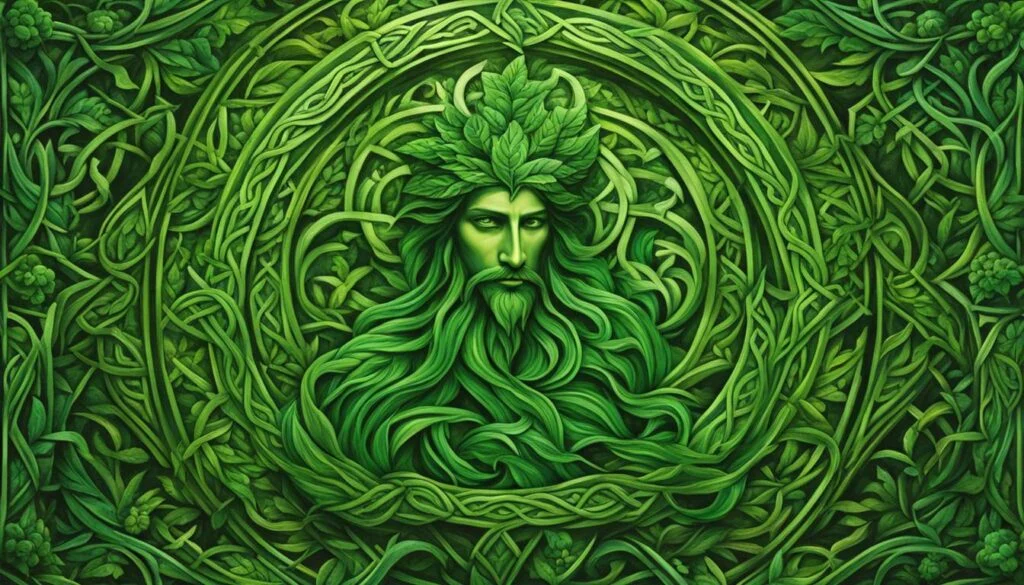
The Golden Legend, a medieval hagiography compiled by Jacobus de Voragine, sheds light on the understanding of the Green Man in Christian symbolism. This legend encompasses the story of Adam’s death and his son Seth’s quest to retrieve the oil of mercy. The tale intertwines with the Green Man, portraying Adam as a figure covered in foliage, symbolizing his profound connection to the Tree of Life.
At the heart of this narrative lies the transformative power of the True Cross, which plays a pivotal role in Christian mythology. The Green Man’s portrayal in the legend emphasizes his significance as a divine symbol, bridging the gap between nature and spirituality.
The Legend of Adam and Seth
In the legend, after Adam’s death, his son Seth embarks on a journey to retrieve the oil of mercy from the Tree of Life. Along his path, he encounters a mysterious figure known as the Green Man, who embodies the essence of nature and its everlasting cycles. Covered in lush foliage, the Green Man reflects the eternal connection between humanity and the natural world.
This depiction of Adam as the Green Man highlights the sacred bond between humanity and nature, representing the interplay between divine creation and the inherent beauty of the Earth.
Symbolism and Significance
The Golden Legend’s association of Adam with the Green Man serves as a powerful symbol of life, renewal, and our connection to the natural world. It underscores the belief that humanity is intricately intertwined with the cycles of nature and extends the metaphor of the Tree of Life found in ancient mythologies.
The Green Man, as depicted in The Golden Legend, embodies the timeless presence of the divine in the natural world and serves as a reminder of our responsibility towards preserving and honoring the sacredness of nature.
The Green Man as a Symbol of Time
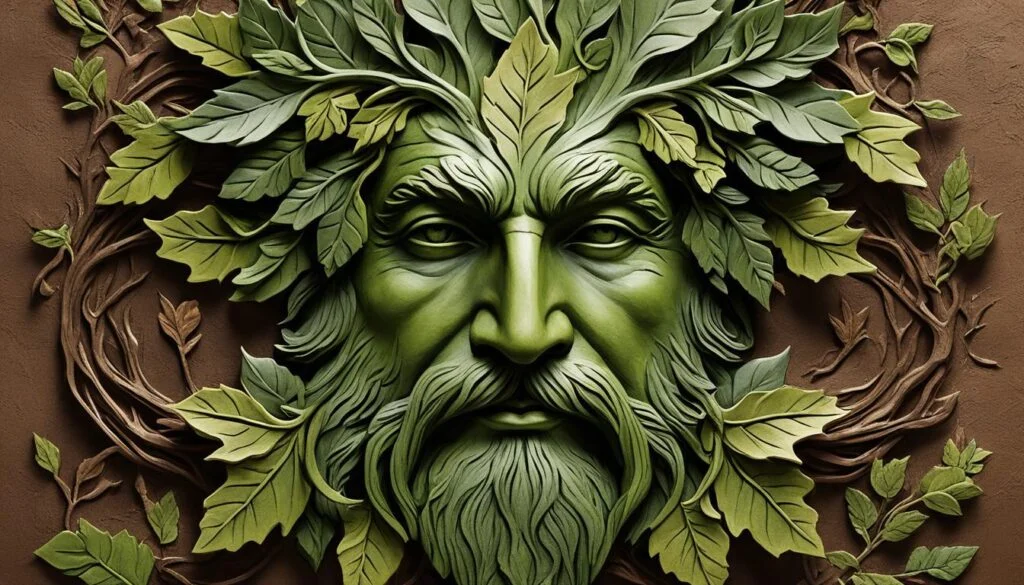
At the core of the Green Man’s symbolism lies the concept of cyclical time and renewal. The Green Man represents the eternal cycle of life, death, and rebirth.
As the wheel of time turns, the Green Man embodies the untamed wilderness that overtakes humanity and the fruits of our labor. He symbolizes the ceaseless struggle between chaos (time) and order (space) and serves as a reminder of the constant regeneration and renewal found in nature’s cycles.
- The Green Man is a symbol of cyclical time, representing the eternal cycle of life, death, and rebirth.
- He embodies the untamed wilderness and the continuous growth and decay of the natural world.
- The Green Man serves as a reminder of the constant regeneration and renewal found in nature’s cycles.
The Green Man’s symbolism of time and renewal resonates with individuals seeking a deeper understanding of the interconnectedness between humans and the natural world. It reminds us of the importance of embracing nature’s rhythms and finding renewal and transformation within the cycles of life.
Variations of the Green Man Symbol
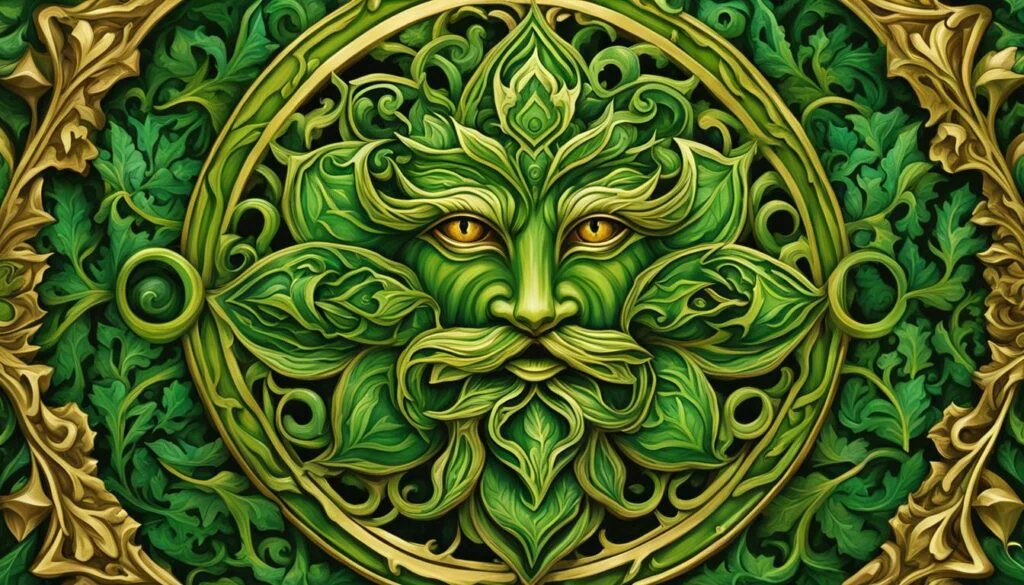
The Green Man motif is depicted in various forms and variations, showcasing the diverse imagery associated with this ancient symbol. Let’s explore some of the different types of Green Men:
Foliate Heads
One common depiction of the Green Man is the foliate head, where the face is completely covered in lush green leaves. This variation emphasizes the connection between the Green Man and nature, symbolizing the abundance and vitality of the natural world.
Disgorging Heads
In some representations, the Green Man is depicted with a disgorging head, where vegetation spews forth from its mouth. This imagery symbolizes the overflowing fertility and the life-giving abundance of the Green Man, as if he is the source from which all growth and sustenance emerge.
Bloodsucker Heads
Another variant of the Green Man is the bloodsucker head, featuring vegetation sprouting from all facial orifices. This imagery represents the interplay between life and death, capturing the cyclical nature of existence and the transformative power of nature’s regenerative forces.
These different types of Green Men can be found prominently in architectural sculptures of both secular and ecclesiastical buildings, particularly in Western tradition. Their striking depictions serve as a visual testament to the enduring symbolism and widespread fascination with the Green Man throughout history.
Historical Origins of the Green Man
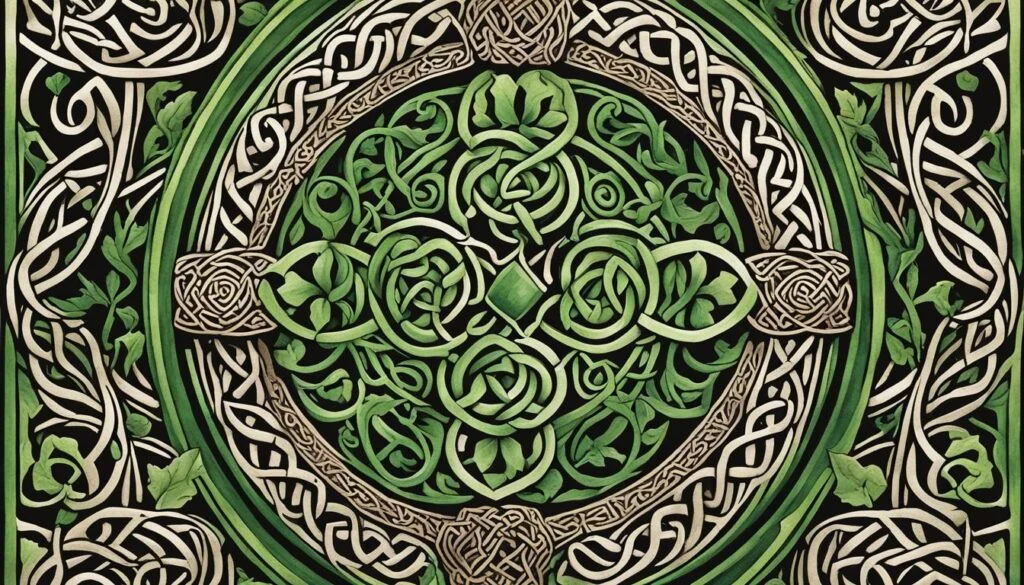
The origins of the Green Man can be traced back to ancient art, particularly in Celtic and Romanesque cultures. In Iron Age Celtic art, similar depictions of faces emerging from foliage can be found, symbolizing gods and mythological figures. These intriguing representations showcase the deep connection between nature and spirituality in Celtic culture. Additionally, early examples of Green Man-like figures can be found in Roman art, where leaf masks were utilized to depict deities and mythological figures. These artistic expressions highlight the significance of the natural world in ancient civilizations.
The Green Man motif eventually evolved and became a prominent feature in medieval European architecture. The use of foliage and vegetation in sculptures and carvings reflected the enduring symbolism of the Green Man as a representation of life and nature. These artistic representations can still be seen today, serving as a testament to the historical origins and cultural significance of the Green Man.
The Green Man in Modern Times
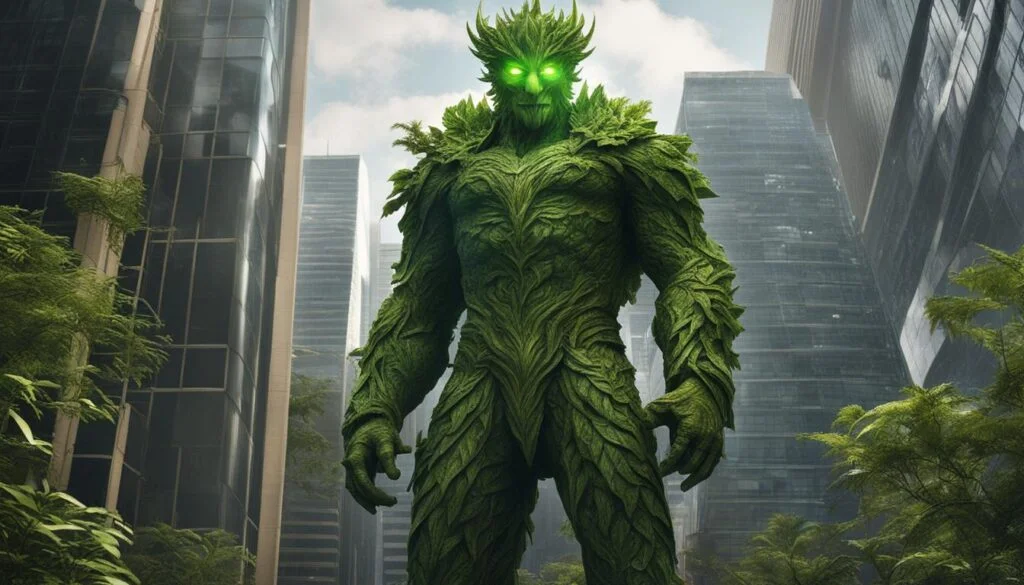
In the 19th and 20th centuries, the Green Man experienced a revival in popularity, particularly in the realms of art and architecture. During the Gothic revival and the Arts and Crafts era, the Green Man became a prominent decorative motif in both religious and secular buildings.
Artists and architects incorporated the Green Man into their works, showcasing his presence in various forms. Often depicted with animal heads, the Green Man appeared in manuscripts, metalwork, stained glass windows, and other mediums, adding a touch of enchantment and natural beauty to these creations.
The Green Man became a symbol of decorative art during this period, capturing the imagination of artists and inspiring intricate, nature-themed designs. This resurgence in popularity ensured that the Green Man remained a beloved and enduring symbol, embraced by artists and architects around the world.
The Green Man in Folklore
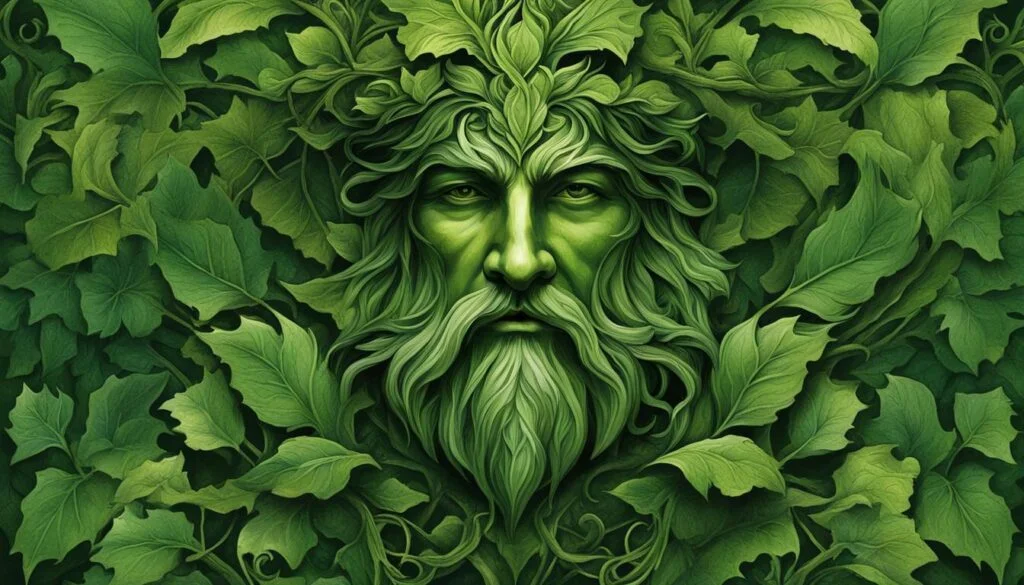
In addition to his presence in art and architecture, the Green Man also holds a significant place in folklore and traditional folk culture. He is often associated with nature spirits, forest guardians, and fertility deities. Green Man figures appear in various cultures around the world and are celebrated in rituals, festivals, and folklore. The Green Man’s connection to the natural world and his representation of fertility and growth make him a revered figure in folklore traditions.
- Green Men figure prominently in British folklore, where they are believed to protect the forests and bring abundance to the land.
- In Celtic mythology, the Green Man is associated with the Oak King, who brings fertility and growth to the land during the summer months.
- In Germanic folklore, the Green Man is known as the Erlking, a supernatural being who dwells in the woods and is associated with death and transformation.
- Green Man stories can also be found in Native American folklore, where he is often depicted as a powerful spirit who oversees the natural world.
The Green Man in Rituals and Festivals
Throughout history, the Green Man has been celebrated in various rituals and festivals that honor nature and its cycles. These celebrations often coincide with the changing seasons and the rebirth of nature.
- The May Day festival, also known as Beltane, is a traditional celebration of spring and fertility in which the Green Man plays a central role.
- In the Jack in the Green festival held in Hastings, England, a person dressed as the Green Man leads a procession through the town to welcome the arrival of spring.
- In the Midsummer’s Eve celebration, the Green Man is invoked to bring luck, fertility, and protection to the community.
Whether as a symbol of protection, fertility, or the cycle of life, the Green Man continues to hold a special place in folklore and traditional folk culture. His presence in rituals, festivals, and stories serves as a reminder of the deep connection between humans and the natural world.
Exploring the Green Man’s Symbolism
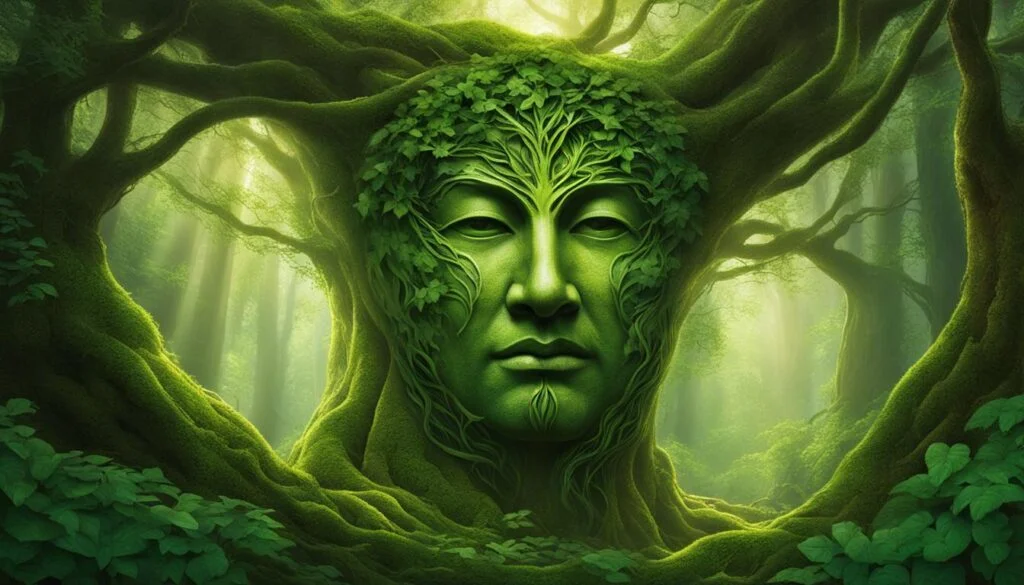
The symbolism of the Green Man can be interpreted in different ways, but at its core, it represents the cycles of life, death, and rebirth. The Green Man’s connection to nature emphasizes the vital role of the natural world in sustaining life. His image serves as a reminder of our interconnectedness with the environment and the importance of preserving and honoring nature’s rhythms.
The Green Man’s symbolism invites us to embrace the cycles of life and find renewal and transformation through our connection to the natural world.
The Symbolism of Rebirth
One of the key themes in Green Man symbolism is rebirth. Just as nature goes through seasons of growth, decay, and renewal, the Green Man represents the continual cycle of life. His image encourages us to embrace change and see each ending as an opportunity for new beginnings. The Green Man symbolizes the resilience and creative force in nature, reminding us that even in difficult times, there is always the potential for growth and transformation.
A Connection to Nature
The Green Man’s strong connection to nature symbolizes the inseparable bond between humans and the natural world. His image urges us to recognize and honor the beauty and power of the natural environment. By embracing the Green Man’s symbolism, we are encouraged to cultivate a deeper reverence for the Earth, to care for its ecosystems, and to live in harmony with nature. The Green Man serves as a reminder that our well-being is intrinsically linked to the health and vitality of the planet.
Embracing Renewal and Transformation
The Green Man’s symbolism inspires us to embrace renewal and transformation in our own lives. Just as the Green Man sheds old growth to make way for new, we too can let go of the past, release what no longer serves us, and embrace personal growth and change. The Green Man encourages us to explore our own inner landscapes, to connect with our authentic selves, and to tap into the wellspring of creativity and vitality that exists within each of us.
The Green Man’s symbolism is a powerful reminder of the inherent cycles of life, the interconnectedness of all living beings, and the transformative power of nature. By embracing this symbolism, we can find inspiration and guidance in our own journey of growth and self-discovery.
Conclusion
The Green Man, deeply rooted in Celtic lore and symbolism, holds profound significance that transcends time. As a representation of life, nature, and rebirth, the Green Man continues to captivate individuals seeking a profound connection to the natural world and a reminder of the cyclical nature of existence.
From his presence in medieval churches to his role in folklore and contemporary art, the Green Man’s enduring symbolism remains steadfast. He serves as a symbol of life’s cycles, representing the intrinsic connection between humanity and the divine beauty of nature.
Whether as a reminder of the ever-present cycle of life or as a beacon of the interconnectedness of all living beings, the Green Man invites us to embrace the profound significance of our place in the world. His enduring presence preserves the ancient wisdom and symbolism that continue to resonate with individuals across cultures and generations.
FAQ
What is the Green Man?
The Green Man is a mystical figure deeply rooted in Celtic lore and symbolism. He symbolizes rebirth and the cyclical nature of life, representing the connection between humans and the natural world.
Where can the Green Man be found?
Carvings and images of Green Men can be found in medieval churches throughout Great Britain. They are often depicted as whimsical and enigmatic faces adorned with foliage and vines.
Why has the Green Man seen a revival in popularity?
The Green Man has experienced a revival in popularity due to his association with nature, rebirth, and spiritual connection. He has been embraced by various movements such as environmentalism and the Neo-Pagan movement.
What is the connection between the Green Man and Christian mythology?
The Green Man is associated with Christian symbolism in the legend of Adam’s death and his son Seth’s journey to retrieve the oil of mercy. Adam is depicted as a Green Man, symbolizing his connection to the Tree of Life.
What does the Green Man symbolize?
The Green Man symbolizes the eternal cycle of life, death, and rebirth. He represents the constant regeneration and renewal found in nature’s cycles and the interconnectedness of all living beings.
What are the different variations of the Green Man symbol?
The Green Man is depicted in various forms and variations, such as foliate heads, disgorging heads, and bloodsucker heads. These different types of Green Men can be found in architectural sculptures in both secular and ecclesiastical buildings.
What are the historical origins of the Green Man?
The Green Man’s origins can be traced back to ancient art, particularly in Celtic and Romanesque cultures. Similar depictions of faces emerging from foliage can be found in Iron Age Celtic art and Roman art.
How did the Green Man gain popularity in modern times?
In the 19th and 20th centuries, the Green Man saw a resurgence in popularity during the Gothic revival and the Arts and Crafts era. The figure became a decorative motif in religious and secular buildings and was embraced by artists and architects worldwide.
What is the significance of the Green Man in folklore?
The Green Man is often associated with nature spirits, forest guardians, and fertility deities in folklore and traditional folk culture. He is celebrated in rituals, festivals, and folklore traditions.
What does the Green Man symbolize in terms of spirituality?
The Green Man symbolizes the cycles of life, death, and rebirth. He emphasizes the importance of our interconnectedness with the environment and the need to preserve and honor nature’s rhythms.
Why is the Green Man significant in modern times?
The Green Man holds significant meaning in modern times as a timeless symbol of life, nature, and rebirth. His enduring symbolism resonates with individuals seeking a deeper connection to the natural world and a reminder of the cyclical nature of existence.


